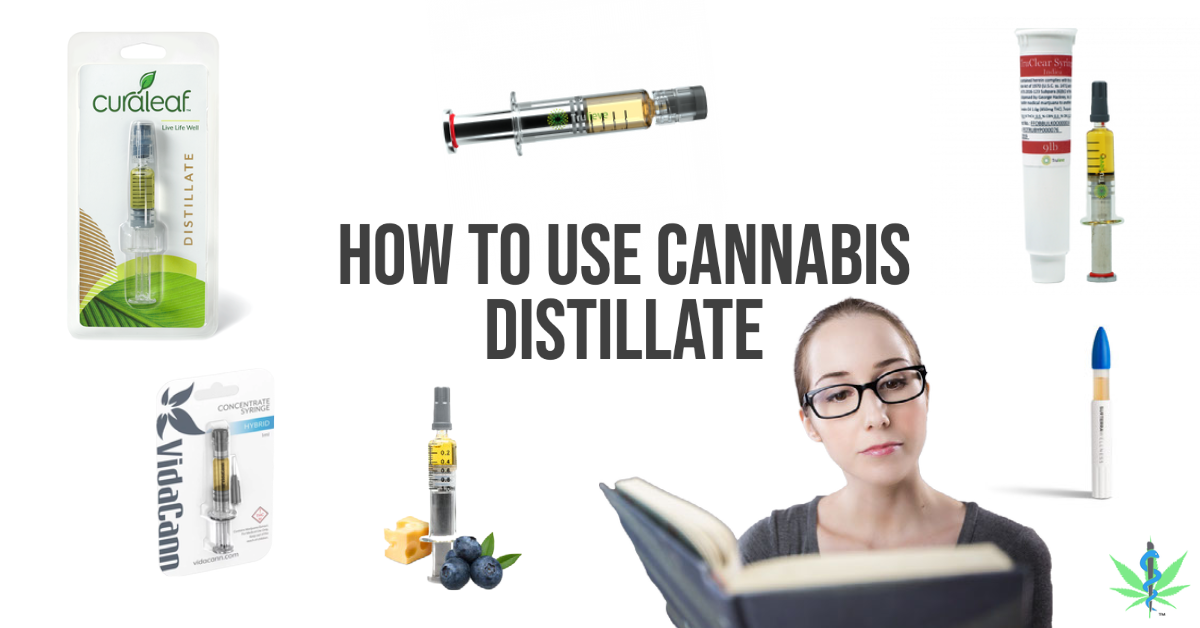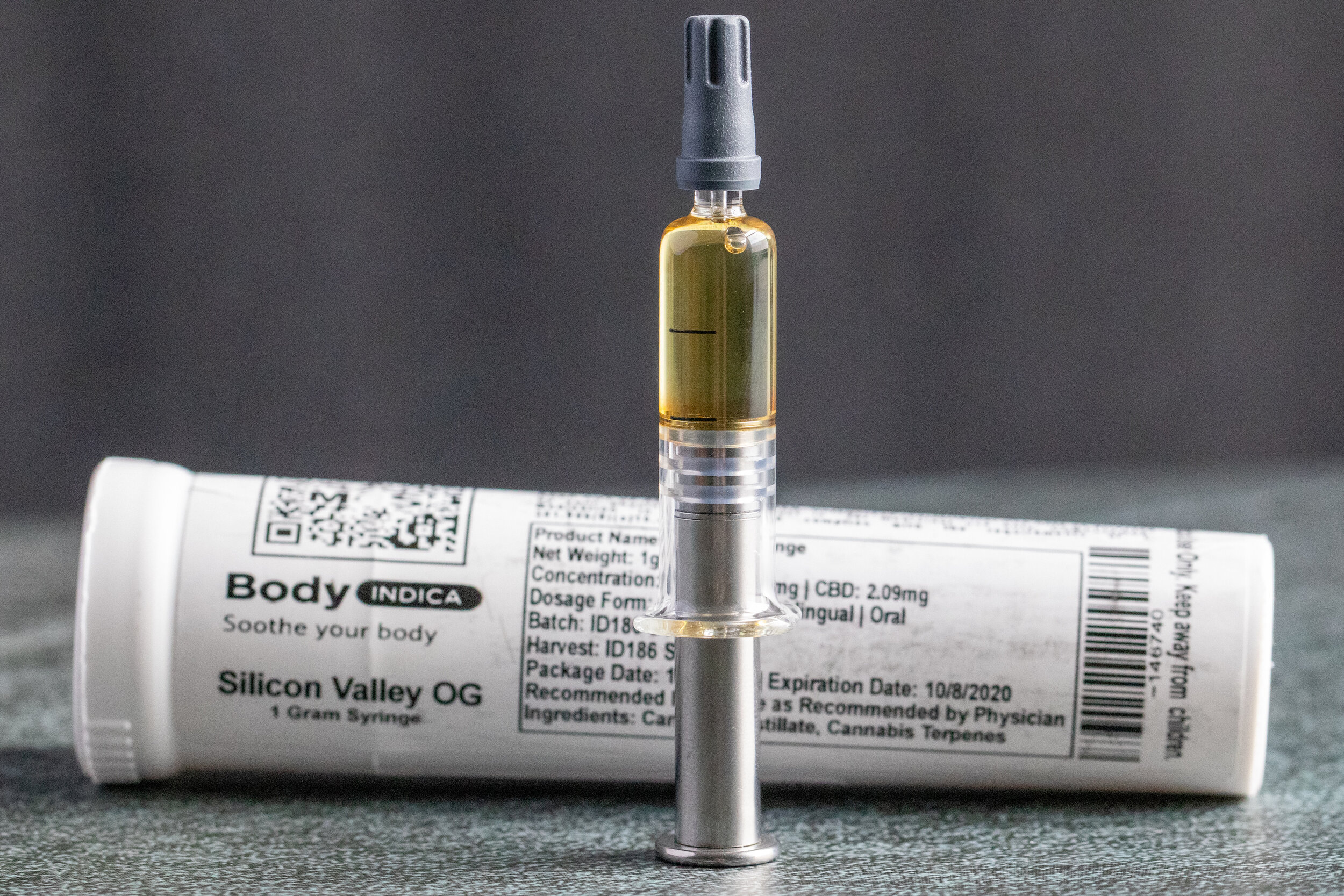You may have heard of distillate in the dispensaries or seen it listed on the menu and wondered, “What can I use distillate for?”
The answer - pretty much everything.
A Little Background on Cannabis Distillate
Distillate is a form of cannabis concentrate in which all of the plant compounds, except a specific cannabinoid (typically CBD or THC), are removed. In its pure form - before adding terpenes, distillate usually lacks any flavor or aroma. Distillate is the primary ingredient in vape cartridges, edibles, tinctures, topicals, and other commercially produced cannabis products.
For patients looking for a versatile product with multiple uses, distillate may be an undervalued and cost-effective option. Distillate is typically sold in a syringe and dosed via a plunger. It’s pre-activated, meaning it’s decarboxylated and can be taken orally with a psychoactive effect. It can also be used topically or inhaled.
Distillate looks like a thick, viscous liquid that is translucent but amber in color. The color tone can change depending on the process used during extraction and any added ingredients. For example, terpenes are destroyed during the distillation process and need to be added back in after the fact. Companies can source terpenes from cannabis or other plants. Distillate made with mostly cannabis-derived terpenes tends to have a dark amber color (but not as dark as RSO oil), and distillate using food-grade terpenes tends to be a light amber or yellow tone.
How to Use Distillate
The versatility of distillate makes it a popular choice among medical patients. There are many ways to administer it, and finding the best one for you can be integral in achieving your specific symptom relief.
Grow Healthy Silicon Valley OG Syringe of Cannabis Distillate
Oral/Edible Dosing
Oral dosing can be helpful for all sorts of symptoms, including long-lasting relief for pain, mood, and insomnia.
Most distillate packaging recommends taking a tiny ‘rice’ sized dose when consuming orally. However, it’s essential to exercise caution as a ‘rice’ sized drop of distillate can be anywhere from 25-50mg - much higher than a standard starting dose (5-10mg) for oral THC. It’s very easy to take too much, which can result in intense psychoactive effects.
Ways to consume distillate orally:
Dose onto a snack (cracker with peanut butter, piece of dried fruit) and eat
Freeze doses on parchment or wax paper and eat as needed
Fill empty gel capsule with dose and swallow
Mix into foods to make own edibles (link to recipe)
Although distillate is pre-activated, some patients with digestive issues may find less benefit from dosing orally. For these patients, it can be helpful to consume the dose with a fatty meal or snack. For example, if using a cracker, add some peanut butter. This fat will assist in the absorption as the distillate digests in your system.
Distillate Syringe
Topical Applications
You can use distillate topically, although most prefer to mix it into other oils or lotions to make it easier to work with. This method can be great for patients looking for localized pain relief. Using distillate topically won’t create any psychoactive effects, which is markedly different from dosing it via other methods. When creating your own topicals, as shown in our guide here, you can control the potency of your mixture, allowing for stronger products than what are sold at most dispensaries. Making your own can also save a ton of money compared to store-bought topicals. This can be an empowering option for patients who may feel the dispensary topicals just aren’t that effective for their symptoms.
Inhaling Distillate
Distillate can even be inhaled. It’s the primary ingredient for vape oil, which is then blended with terpenes to mimic strain effects. Just like the DIY topical and edibles mentioned above, you can fill your own vape cartridges with distillate. You can also inhale distillate via a dab rig or other vaporization device.
The benefit of inhalation is it’s quick onset - it’s the fastest delivery method a patient can utilize when dosing distillate. Because distillate is highly concentrated, inhaled effects can feel more intense than consuming a similar amount of vapor or smoke from flower. Using caution, and going low and slow with distillate, is important with all delivery methods, including inhalation.
Distillate Drawbacks
RSO Syringe (left) vs Distillate Syringe (right)
We learned that distillate is a highly versatile option that can often save patients money. But what are the drawbacks?
First, distillate is a highly refined cannabis product. It’s as far from the whole plant as we can get. The plant is processed down to only it’s primary compound. While the psychoactive effects can feel intense because of the concentration of THC, some patients notice that the overall experience of distillate feels different. We’ve heard many patients compare the effects of inhaled distillate as opposed to smoking as “hollow.” This experience is likely due to the lack of other cannabinoids, terpenes, flavonoids, and other compounds that contribute to the entourage effect.
Despite this drawback, distillate is still an effective and affordable option for many patients, especially when used in conjunction with other whole-plant medicines.
Florida Options
Most MMTC’s/dispensaries offer distillate products or a similar concentrate oil (CO2 oil). They may be labeled clearly as distillate or with a proprietary name specific to the dispensary. For example, Trulieve calls their distillate product Truclear, while Surterra calls their CO2 oil Pure Reserve Oil. While technically they are different products, you can use distillate and CO2 oil interchangeably. For more information on Florida concentrates, check out this post.








